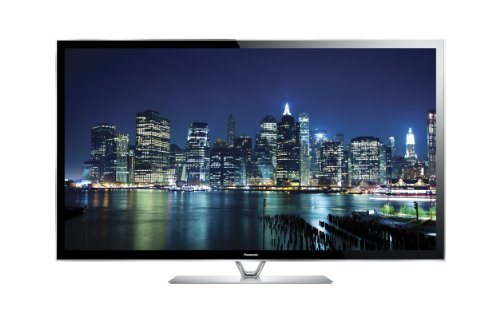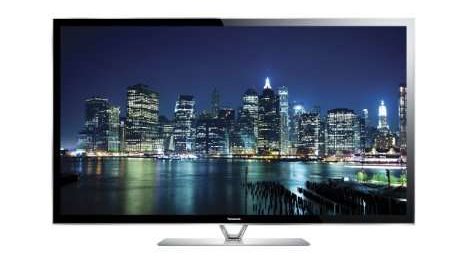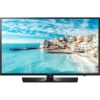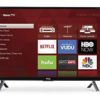
FEATURED Panasonic TC-P65ZT60 65-Inch 1080p 600Hz 3D Smart Plasma TV
- Studio Master Panel, Experience ultimate black color, contrast and crisp images
- One Sheet of Glass Design: Eliminate gaps to produce optimized picture with elegant aesthetics
- 30,720 Gradation Steps: Superior shadow definition allows for a richer viewing experience
- DCI 98% Color Space: Enjoy cinema-quality picture and color reproduction
- TV without stand (Width x Height x Depth): 59.4 X 34.9 X 1.82 Inches, TV with stand (Width x Height x Depth): 59.4 X 38.6 X 12.8 Inches
Panasonic ZT60 Series Plasma HDTV (60 and 65-Inch)
A true leap forward in picture quality performance
The top-of-the-line ZT60 series features a Studio Master Panel with air gapless technology which offers reference-level optical performance with superb bright-field contrast and sharp, crisp images. By eliminating the conventional air layer between the panel and the front glass, the Studio Master Panel minimizes reflections from external light and improves panel light transmission, for the ultimate big-screen picture quality.
This TV has a sleek, minimalist design featuring one sheet of glass and narrow metal bezel. What’s more, each member of the household can have their very own personalized screen. Choose a standard, preset configuration, or create your own fully customized screen tailored specifically to your taste.
Crisp, Moving Pictures
3000 Focused Field Drive technology allows for high motion-image perfo











Comments
3 comments
vqworks
January 29, 2014
The Current Industry Standard In Picture Quality,
As a consumer who actually bought the ZT60, I think I can put a few things into perspective. Back in ’09 I saw a demo of a 50″ Pioneer Kuro plasma (the industry reference for black level quality until now) at a store with the lights switched off. Yes, I was impressed. Blacks looked visibly black. A couple of months ago I went to a Magnolia (Best Buy) store to see if the ZT60 could live up to its hype. The ZT60 was not in a controlled demo room but was placed on a wall directly under a VT60 with a lot of ambient store lighting. Under such lighting conditions, I honestly couldn’t see the difference in black level between the VT60 and the ZT60. The main advantage of the ZT60 under bright lighting was somewhat less reflectivity/screen glare. I asked for a demo in the dark demo room but only a VT60 was in the room. I checked out the blacks using night scenes off my own “Taxi Driver” and “American Werewolf in London” BluRay discs. Blacks were inky black. Since I couldn’t do an A-B comparison between a VT60, ZT60, or the Pioneer Kuro TV for black level using the same material the best I can do was base my comparisons of black level on memory. Given the Kuro’s already impressive performance, can anything else “blow it out of the water”, as some posters on CNET put it? I’ll just say that the Kuro has finally been laid to rest. But let me say that when a black screen appears on the VT60 it looks extremely dark already.
When looking at a black screen on my ZT60 at home at night with the lights off, it appears that the unit is practically turned off (really). At that level, it’s just an exercise in futility to compare it to a Kuro and split hairs. It’s plenty good enough for me.
In overall performance it handily beats the very best LED backlit LCDs I’ve seen, including the current Ultra HD 4K sets (except in resolution) I’ve seen (since all of them use LED backlighting). At this point, you may be wondering why I would compare a 1080P HDTV to a 2160P (4K) set. Based on the demos of 4K sets that I’ve seen on 60 to 65-inch screens, the difference (really just resolution) between 1080P and 2160P is only visible when you are standing several inches in front of the screen. Most people would rather view from several feet away in a living room setting. Also, the 4K demo material is video-based. I can’t imagine seeing any more detail even from a transfer of a 70mm film print when seated at a normal viewing distance in a living room. In terms of 4K sources, the Blu-Ray format does not support that resolution, leaving Sony to offer a $600 4K media box that only works with their own brand of 4K TVs. There’s another alternative in the form of an even more expensive source component. But all this points to a shaky start for yet another format that provides little benefit to consumers. In fact, 4K is just a transitional format for the 2nd tier of the Ultra HD standard, 8K. So why buy 4K at all? Anyway, I digress.
Back to the subject of overall picture quality. With all the statements about black level, you’d think that that was the only important picture parameter. I’ll say that one of the first things I noticed about both the VT60 and ZT60 were the great reproduction of different shades of gray (maybe better than the Kuro set which had a tendency to crush dark shades of gray to black). On the ZT60 there seems to be, if anything, also a noticeable advantage in the reproduction of red. Reds are reproduced with a natural purity I’ve never seen before. I can’t comment on the 3D performance of the ZT60 because I don’t have a 3D BluRay player but I briefly converted a 2D Blu-Ray to 3D. The motion seemed to appear with the “soap opera” (video) effect. That said, 3D performance is not important to me so I consider the feature to be a “throw in” anyway.
My only pet peeve about all the professional reviews I’ve read about the ZT60 is the statement that SD sources look great. While it’s true that DVDs appear extremely good on the ZT60 when using an HDMI connection, the aforementioned statement is obviously based on the reproduction of DVDs (which occasionally look like HD sources) and broadcasts. I say this because there is no support for legacy sources that use the S-Video connection. I’ve seen so many professional reviewers trash this connection by saying that making an S-Video connection was awkward (well, you don’t do it often, do you?). Yet, there is no criticism of the old composite video connection’s quality. I don’t think a professional reviewer would mind putting up with the minor inconvenience, given the composite connection’s dot crawl from inherent crosstalk between the luminance (black & white) and chrominance (color) signals. As expensive as the ZT60 is, you’d think that an S-Video input would be included. How much can such an input cost? I make a big deal about this because I have a lot of S-VHS recordings of material I simply can’t buy or don’t care to buy again in…
Read more
Was this review helpful to you?

|Simon
January 29, 2014
Panasonic’s Flagship Reference TV,
I got my ZT60 in May, so I guess I am one of the grandfathers. I wanted to get a good TV last year, but VT50 wasn’t quite there yet. This year was very exciting for all AV enthusiasts with Samsung F8500, VT60, and ZT60. Samsung was released earlier, and it was quite promising, but I hold up until the release of ZT60 when I could compare them side-by-side. Although VT60 is very close to ZT, it was never on my list; to explain, one critical decision point for me was the air-free panel, and VT has the air gap between the glass and plasma screen which may produce unwanted shadows. Samsung is a very good TV, and let’s face it, it’s a fantastic TV, but I chose ZT because of a few personal reasons. In my opinion, ZT has better pedestal, it has better black levels and shadow details, and it is THX certified. Some may disagree, but I wanted the closest to the reference picture that I could get, and that was the ZT. Samsung has the advantages of being super sharp, super bright, and having no “Fan Noise” issue.
The only problem I had with my ZTs was the “Fan Noise,” and I exchanged my sets a few times. Thankfully, Panasonic has a “Foam Fix” now. Fan Noise is something different than the well-known Plasma buzz, and not too many people will experience this; however, if you are one of the unlucky ones, this will eat you to the bone. Fan noise first identified by the European AV website on the VT series, and they found out if the back panel is removed, there is no noise. So, the noise is not coming from the fans per se, but from the airflow they create in relation to the back panel. The noise is like pulsation and whirling that some people have described as having an old fridge running in the room. It has been reported that Panasonic has a fix now that reduces the noise, and it contains a set of foams that will be installed underneath the fans. A service call to Panasonic will send you a technician to install the foams.
Picture quality of ZT is fantastic. If you have a bright room though, you may also consider F8500, since it can go much brighter than ZT. As a matter of fact, according to the shootout, ZT is the dimmest of all, and even VT has better brightness compared to ZT. However compared to VT, ZT has a superior antireflective filter that should help with ambient lights. I also like the slimmer form factor of ZT without the side speakers.
I came from LCD, so I was a complete stranger to Plasma technology. It seems that Plasma phosphors age exponentially in relation to time, so the first 100 hours is extremely crucial to a steady picture quality. It is advised that you run the slides–like D-Nice’s–for at least 100 hours so the red, green, and blue phosphors age evenly. After this period, you should be fine with any contents. I have tested this myself, and it really makes a difference to run the premade slides. You can search for D-Nice’s 2013 Panasonic settings, and download the slides. If you are really serious about PQ, you should also consider a professional calibration to get every last bit of the reference picture out of your set. The slides will also help you prepare your panel for the required initial 300 hours for a professional calibration. If you ever need to check the panel hours, you need to go to the service menu, which also can ruin your TV if you are not careful and voids your warranty. However, if you need to access the panel hours anyway:
*** WARNING: use it at your own risk. Changing settings can void the warranty ***
* Press and hold the {VOL -} key on the side of the set, and without releasing, press the {INFO} button on the remote 3 times.
* After a few seconds you are in the service menu.
* Press {2} key on the remote to select “SRV-TOOL,” then press {OK} key.
* Go down to “PTCT: 00.00.00.00.00” and move right using remote’s cursor keys.
* Press and hold {MUTE} button on the remote for 3 seconds.
* Time and number of power cycles will be shown in red.
* To exit, just hold down the power button on the set (not the remote).
The apps on the TV are pretty basic, but all the important ones are there: Netflix, Amazon Instant Video, Hulu, Vimeo, YouTube, and etc. The DLNA Server app can only play x264 files from my NAS, and it doesn’t support DivX or Xvid. Web browser app is pretty basic, but it works. I used my Bluetooth keyboard and it connected without any problems. Overall, this TV is nicely packed with apps, and there are a few extra ones that you can download within the TV. One annoying thing for me was the Viera Connect Banner which is a fancy name for unauthorized advertisement on your TV. You can turn it off from: {Menu}->”Setup”->”Display Customization”->”Viera Connect Banner”->”off.” Just make sure you are on the full screen home page on a normal HDMI input, since the option does not appear in every apps/inputs.
I’ve never owned a 3D TV before, so this is my first. I immediately…
Read more
Was this review helpful to you?

|SciRe
January 29, 2014
Panasonic P65ZT60 review and comparisons with P65VT60 and Sony 65W850A,
I looked for a few months for a high-quality TV to replace my almost 6 years old Sony 52XBR4 (52-inch 1080p, 120Hz) LCD TV in my family room. This XBR4 LCD TV has CCFL backlights that were used before the more recent LCD TVs moved to LED backlighting. Today’s LCD TVs are usually called LED TVs because of their LED backlights. The old Sony XBR4 TV is still one of the best 2D TVs of any kind today, with precise picture details, strong colors and good viewing angles, but mine developed some intermittent display panel issues that cannot be fixed. For me high quality of 2D picture is by far the most important attribute of any TV, with everything else far behind. I had never owned a plasma TV before. Knowing the Best Buy’s good return/exchange policy (no extra cost to me, plus very good and free home delivery and TV stand assembly every time) I decided to try some top plasma and LED TVs at home before I settle on the best one for me. I did not want to go for a 4K/UHD TV mainly because of their still extremely high price (for a 65-inch or larger TV), the picture quality with 1080 i/p HD sources was not visibly better from my normal viewing distance, and no meaningful quantity of 4K/UHD programs is or will be available any time soon. Also, all current 4K/UHD TVs are LED TVs that similarly to the today’s 1080p HD LED TVs suffer from limited viewing angles as their picture fades significantly when viewed from more than 20 degrees or so away from straight in front of the TV.
I don’t have a preferred brand but do consider the company commitment to product performance, quality and support. Product performance (picture quality for TVs) is more important to me than the price, within a reasonable and affordable price range. I first purchased a Panasonic P65VT60, 65-inch plasma TV from a local Best Buy store. I returned it about two weeks later and replaced it with a Sony 65W850A, 65-inch LED TV. I returned it as well and replaced it a week later with a Panasonic P65ZT60, 65-inch plasma TV, which I still enjoy very much. Although I bought all these three TVs from a local Best Buy store, I posted my reviews here on Amazon. I like Amazon reviews, use them often before buying things, and I can update my reviews later if I want or need. I also considered and made some comparisons with the Samsung’s top 64-inch plasma TV, PN64F8500, and its 65-inch UN65F8000 LED TV, but that was based on in-store evaluations only.
To some readers it may be useful to know that all these three TVs (the ZT, VT60 and W850A) were manufactured in October 2013. They were used and evaluated in my family room that has large windows on one side. My open-style kitchen is behind me when sitting straight in front of the TV. The room does not have any direct sunlight but normally receives enough daylight to read a book. In the evening and at night there are usually ceiling lights in the kitchen behind me when watching TV, and I often have ceiling lights on above me and the TV. The TV sits on a floor stand about 2 feet from the floor. I usually sit about 12 feet from the TV straight in front of it and occasionally about 6 to10 feet from the TV and up to 50 degrees to the side from straight in front of the TV.
My typical TV watching is via an HD cable (1080i) through an HD DVR connected to the TV via a high-quality HDMI cable. The programs my family and I normally watch are: NBA, soccer and NFL games, movies, news, business news, golf, music concerts, TV shows, all mostly in HD but some are 4:3 SD with vertical black side bars. Some HD movies I watch are wide, 2.35:1, with horizontal black bars at the top and bottom of the screen. The HD source content is usually of good quality, but there are still many shows and movies on HD channels that clearly are not of 1080i HD quality although they are labeled as HD. I also watch Blue-ray movies and concerts from time to time, all via a high-quality HDMI cable.
<< Detailed review of P65ZT60 Picture Quality >>
It’s difficult to describe how good picture quality (PQ) is on the ZT when fed with a high-quality 1080 i/p HDMI input without seeing it for yourself. All colors look very deep and strong/solid, not just the predominantly mentioned (in online reviews) inky black color. The screen brightness is very good. Picture details, including the edges of people and objects are so well defined and separated from the background that the picture appears very real and often almost 3D deep in high-quality scenes. I did not notice this as much when watching this TV in the store, so if you want to check it for yourself you may need to buy one, feed it some good 1080 HD source content, adjust the picture settings to your liking, and enjoy it. Buy it from a store or online seller that has a good return/exchange policy, so your only risk is that you may like it a lot and keep it like me. Keep in mind though that lower-quality video content will look lower quality like on…
Read more
Was this review helpful to you?

|Write a Reply or Comment: